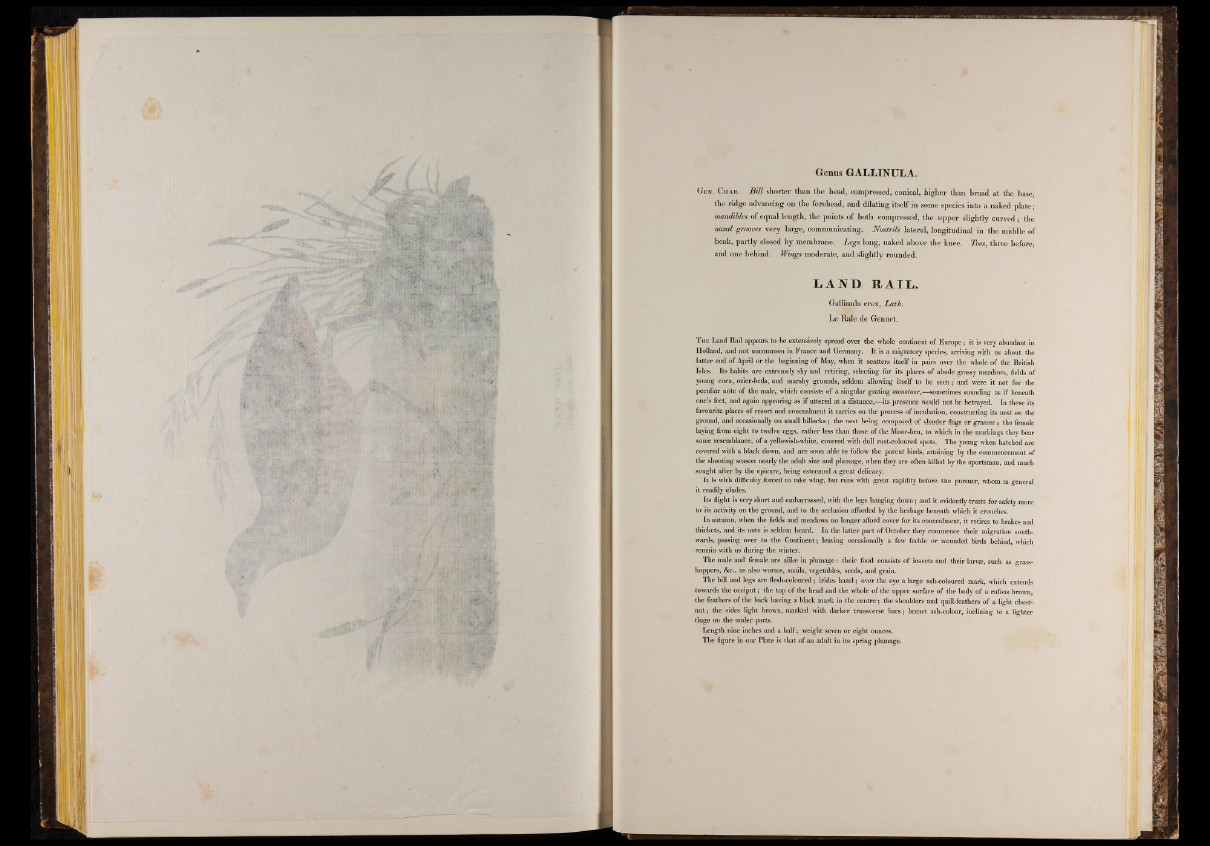
Genus GALLINULA.
G e n . C h a r . B i ll shorter th an th e he ad, compressed, conical, h igh e r than b road a t th e base
th e r id g e advancing on th e forehead, and d ilating itse lf in some species into a naked p la t e ;
m andibles o f equ a l len g th , th e points o f b o th compressed, th e u p p e r s lig h t ly c u r v e d ; the
n a sa l grooves v e r y la rg e , communicating. N o s tr ils lateral, longitu dinal in th e middle o f
b e a k , p a r t ly closed b y membrane. L e g s lon g , nak ed ab ove th e knee. Toes, three before,
and one behind. W ings moderate, and s lig h t ly rounded.
LAND RAIL.
G allin u la c re x, L a tli.
L e R a le de Gennet.
T he Land Rail appears to be extensively spread over the whole continent o f Europe; it is very abundant in
Holland, and not uncommon in France and Germany. It is a migratory species, arriving with us about the
latter end o f April or the beginning o f May, when it scatters itself in pairs over the whole o f the British
Isles. Its habits are extremely shy and retiring, selecting for its places o f abode grassy meadows, fields of
young corn, ozier-beds, and marshy grounds, seldom allowing itself to be seen; and were it not for the
peculiar note o f the male, which consists o f a singular grating monotone,— sometimes s ou nd in g as i f beneath
one’s feet, and again appearing as i f uttered at a distance,— its presence would not be betrayed. In these its
favourite places o f resort and concealment it carries on the process o f incubation, constructing its nest on the
ground, and occasionally on small hillocks; the nest being composed of slender flags or grasses; the female
laying from eight to twelve eggs, rather less than those o f the Moor-hen, to which in the markings, they bear
some resemblance, o f a yellowish-white, covered with dull rust-coloured spots. The young when hatched are
covered with a black down, and are soon able to follow the parent birds, attaining by the commencement of
the shooting season nearly the adult size and plumage, when they are often killed by the sportsman, and much
sought after by the epicure, being esteemed a great delicacy.
It is with difficulty forced to take wing, but runs with great rapidity before the pursuer, whom in general
it readily eludes.
Its flight is very short and embarrassed, with the legs hanging down; and it evidently trusts for safety more
to its activity on the ground, and to the seclusion afforded by the herbage beneath which it crouches.
In autumn, when the fields and meadows no longer afford cover for its concealment, it retires to brakes and
thickets, and its note is seldom heard. In the latter part o f October they commence their migration southwards,
passing over to. the Continent; leaving occasionally a few feeble or wounded birds behind, which
remain with us during the winter.
The male and female are alike in plumage: their food consists o f insects and their larvae, such as grasshoppers,
&c., as also worms, snails, vegetables, seeds, and grain.
The bill and legs are flesh-coloured; irides hazel; over the eye a large ash-coloured mark, which extends
towards the occiput; the top o f the head and the whole o f the upper surface o f the body o f a rufous brown,
the feathers o f the back having a black mark in the centre; the shoulders and quill-feathers o f a light chestnut
; the sides light brown, marked with darker transverse bars; breast ash-colour, inclining to a lighter
tinge on the under parts.
Length nine inches and a half; weight seven or eight ounces.
The figure in our Plate is that o f an adult in its spring plumage.